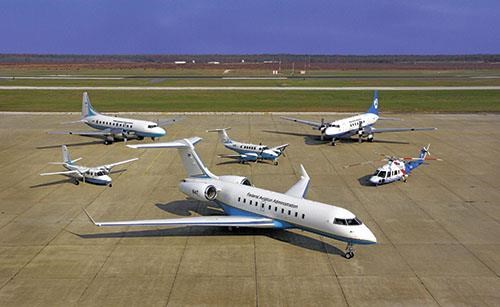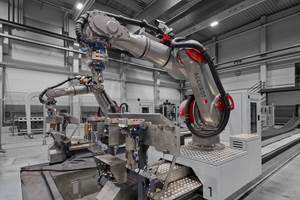The FAA: Keeping up with aerocomposites evolution
Composite and metallic structures must conform to the same performance-based standard of safety.
The Greek philosopher Heraclitus of Ephesus once said, “Change is the only constant.” We can see the inherent truth behind this statement when we look at the evolution of materials in aerospace. The Wright Flyer was the first successful heavier- than-air powered aircraft. Built in 1903, the Flyer had a wooden frame. The straight parts were spruce and the curved parts were ash. The frame was covered with a finely woven cotton cloth and was sealed with canvas paint similar to what mariners of the time used on their sails1-3. In the next era of aircraft construction, builders used metallic alloys, which were much stronger than wood, allowing for improved performance. Today, most aircraft are constructed from a combination of metallic and composite materials as performance continues to improve.
The Boeing Co. (Chicago, IL, US) first used fiberglass in its 707 passenger jet in the 1950s, and it comprised roughly 2% of the structure. Since that time, each generation of Boeing aircraft has had an increased percentage of composite materials. Boeing’s 787 Dreamliner is approximately 50% (by weight) composites4. Airbus, Boeing’s main competition in the large transport aircraft category, has countered with the A350, which makes extensive use of composites, as well, also roughly 50% by weight. However, because safety is the number one priority of the aerospace industry, materials have evolved gradually over time.
In the late 1970s and early 1980s, NASA, through its Aircraft Energy Efficiency (ACEE) Advanced Composites Structures Program, challenged large-transport manufacturers to use graphite material to redesign existing aircraft components. The program’s goal was to develop the necessary data and technology to achieve production commitments to advanced composites. The graphite/epoxy horizontal stabilizers that were developed by Boeing for its 737 as part of this effort were put into commercial service in 1984. They have performed outstandingly, with no service incidents reported5. This led to increased confidence in, and acceptance of, composites for primary aircraft structure.
The mission of the FAA is to provide the safest, most efficient aerospace system in the world. The FAA develops aviation regulations that set the minimum acceptable levels of safety in aviation. As materials and structures continue to evolve, the FAA constantly must evaluate the adequacy of its regulations, policy and guidance materials. Title 14 of the Code of Federal Regulations (CFR) contains all of the regulations for aeronautics and space6. These regulations are generally performance-based rather than prescriptive, which means both composite and metallic structures have to perform to the same standard of safety.
In addition to certifying the aircraft flying in the United States National Aerospace System (NAS), the FAA is proactively working to ensure the safe transition to composites. The William J. Hughes Technical Center (Atlantic City, NJ, US) is the FAA facility in which engineers research a wide variety of materials, including composites. In 2003, the FAA created the Joint Advanced Materials and Structures (JAMS) Center of Excellence7, a consortium of universities that conducts research for the FAA in the areas of testing and analysis, bonding and repair, damage tolerance, environmental factors and crashworthiness. The FAA, the aerospace industry and academia work side by side continually to raise the bar for safety.
The FAA also takes a proactive approach towards composites through the Composite Materials Handbook-17 (CMH-17), which provides information and guidance necessary to design and fabricate end items from composite materials. Its primary purpose is the standardization of engineering data development methodologies related to testing, data reduction and reporting of property data for current and emerging composite materials8. Experts from all over the world meet each year to develop content for the Handbook, which is used by the industry when constructing composite parts for aircraft. The FAA also provides guidance directly to industry through Advisory Circulars (ACs). AC 20-107B sets forth an acceptable means for manufacturers to comply with 14 CFR regarding airworthiness type certification requirements for aircraft structures that involve fiber-reinforced materials. It also includes information on material and process control, manufacturing, structural bonding, environmental considerations, protection of structure, generating design values, structural details, proof of structure for static strength and fatigue and damage tolerance, as well as repair, inspection, crashworthiness, fire protection, flammability, thermal issues and lightning protection9. This AC was most recently updated in 2009. However, because the industry is constantly evolving, the next revision is not too far down the road.
Another high priority for the FAA is educating the composites workforce, which is essential to continued certification efficiency and operational safety. Success here depends on FAA workforce knowledge of composites technologies. With this in mind, the FAA created Composite Manufacturing Technology (CMfgT), Composites Structures Technology (CSET) and Composites Maintenance Technology (CMT) courses for its aviation safety inspectors. Courses are offered by the National Institute for Aviation Research (NIAR) at Wichita State University10. FAA composites educational initiatives also include developing a course and proficiency specimens for airline inspectors and updating 14 CFR Part 147 composites training requirements for aviation maintenance schools.
NASA also is very active in composites research, and has created the Advanced Composites Consortium to develop technologies and methodologies that will enable more efficient design and implementation of composites in aerospace11. The FAA is continuously coordinating with NASA and other government agencies to foster these developments.
The advantages of building aircraft with composites — high specific strength, superior fatigue properties, damage tolerance and the absence of corrosion — continue to make composites an attractive option for aircraft designers. Along with the industry, the FAA is working hard to ensure that composite aircraft continue to soar safely through our skies.
References:
1 https://en.wikipedia.org/wiki/Wright_Flyer
2 https://airandspace.si.edu/exhibitions/wright-brothers/online/fly/1903/construction.cfm
3 http://www.wright-brothers.org/Information_Desk/Just_the_Facts/Airplanes/Flyer_I.htm
4 http://www.appropedia.org/Composites_in_the_Aircraft_Industry
5 http://ntrs.nasa.gov/search.jsp?R=19950022068
6 http://www.ecfr.gov/cgi-bin/text-idx?SID=9e421a89427d784567b3efb495188ac2&mc=true&tpl=/ecfrbrowse/Title14/14cfrv1_02.tpl#0
7 http://www.jams-coe.org/
8 https://www.cmh17.org/
9https://www.faa.gov/regulations_policies/advisory_circulars/index.cfm/go/document.information/documentID/99693
10 http://www.niar.wichita.edu/edu/composites_training.asp
11 http://www.compositesworld.com/news/nasa-establishes-partnership-to-accelerate-aircraft-composites
Related Content
Plant tour: Aernnova Composites, Toledo and Illescas, Spain
RTM and ATL/AFP high-rate production sites feature this composites and engineering leader’s continued push for excellence and innovation for future airframes.
Read MoreFirst Airbus A350 crash confirmed in Haneda
Shortly after touch-down, a JAL A350-900 aircraft recently collided with a De Havilland Canada Dash 8. Exact circumstances are still unknown.
Read MoreDevelopment of a composite liquid hydrogen tank for commercial aircraft
Netherlands consortium advances cryogenic composites testing, tank designs and manufacturing including AFP, hybrid winding, welding of tank components and integrated SHM and H2 sensors for demonstrators in 2025.
Read MoreAutomated robotic NDT enhances capabilities for composites
Kineco Kaman Composites India uses a bespoke Fill Accubot ultrasonic testing system to boost inspection efficiency and productivity.
Read MoreRead Next
Scaling up, optimizing the flax fiber composite camper
Greenlander’s Sherpa RV cab, which is largely constructed from flax fiber/bio-epoxy sandwich panels, nears commercial production readiness and next-generation scale-up.
Read MoreCutting 100 pounds, certification time for the X-59 nose cone
Swift Engineering used HyperX software to remove 100 pounds from 38-foot graphite/epoxy cored nose cone for X-59 supersonic aircraft.
Read MoreNext-gen fan blades: Hybrid twin RTM, printed sensors, laser shock disassembly
MORPHO project demonstrates blade with 20% faster RTM cure cycle, uses AI-based monitoring for improved maintenance/life cycle management and proves laser shock disassembly for recycling.
Read More























